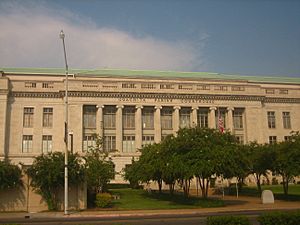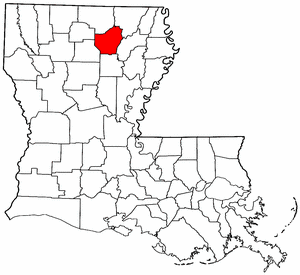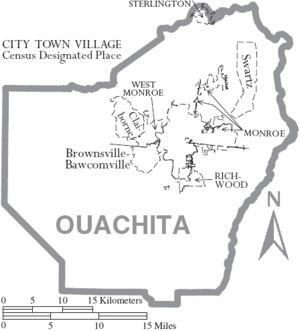Ouachita Parish, Louisiana facts for kids
Quick facts for kids
Ouachita Parish, Louisiana
|
|||
|---|---|---|---|
| Parish of Ouachita | |||

Ouachita Parish Courthouse in Monroe was built in the 1930s by the contractor George A. Caldwell
|
|||
|
|||

Location within the U.S. state of Louisiana
|
|||

Louisiana's location within the U.S.
|
|||
| Country | |||
| State | |||
| Region | North Louisiana | ||
| Founded | March 31, 1807 | ||
| Named for | Ouachita people | ||
| Parish seat (and largest city) | Monroe | ||
| Area | |||
| • Total | 1,640 km2 (632 sq mi) | ||
| • Land | 1,600 km2 (610 sq mi) | ||
| • Water | 50 km2 (21 sq mi) | ||
| • percentage | 9 km2 (3.4 sq mi) | ||
| Population
(2020)
|
|||
| • Total | 160,368 | ||
| • Rank | LA: 8th | ||
| • Density | 97.97/km2 (253.75/sq mi) | ||
| Time zone | UTC-6 (CST) | ||
| • Summer (DST) | UTC-5 (CDT) | ||
| Area code | 318 | ||
| Congressional district | 5th | ||
Ouachita Parish (which means Parish of Ouachita in French) is a special kind of county called a parish in northern Louisiana. In 2020, about 160,368 people lived here. The main city and government center is Monroe. The parish was created in 1807.
Ouachita Parish is part of the larger Monroe area. It is home to Watson Brake, which is the oldest known earthwork mound complex in North America. These mounds were built around 3500 BCE. That makes them even older than the famous Ancient Egyptian pyramids or Britain's Stonehenge! Watson Brake is on private land, so you can't visit it.
Contents
History of Ouachita Parish
Ancient History and Early Peoples
Long before Europeans arrived, many different Native American groups lived in Ouachita Parish. Over thousands of years, people from cultures like the Marksville culture, Troyville culture, and Coles Creek culture built villages and mounds throughout the area. A great example is the Filhiol Mound Site, which is located on a natural levee (a raised bank) of the Ouachita River.
European Settlement and Growth
The parish gets its name from the Ouachita River, which flows through this part of Louisiana. Around 1720, French settlers came to the area. They started farms on Bayou DeSiard, where they used the labor of enslaved African people.
However, the Natchez Revolt in 1729-1731 caused the French to leave the Ouachita farms. Later, in the 1750s, Choctaw Indians began hunting in northern Louisiana. Only a few French families moved back north.
In 1769, Alejandro O'Reilly, the first Spanish governor to successfully rule West Louisiana, claimed Ouachita Parish for Spain. France had given up its lands east of the Mississippi River to Great Britain in 1763 after the Seven Years' War. Spain then took over French lands west of the Mississippi, including Louisiana. A count in 1769 showed 110 white people living in the parish. Spain also stopped the trade and practice of enslaving Native Americans in its colonies that year.
In 1783, Don Juan Filhiol, a Frenchman working for the Spanish government, was sent to create the first European outpost in the Ouachita River Valley. It was called Poste d'Ouachita. He traveled by keelboat with his wife, some soldiers, and enslaved people. The journey up the rivers was long and difficult. By 1785, only 207 Europeans lived in the entire Ouachita District.
Filhiol settled at Prairie des Canots (now Monroe) in 1785. He helped organize settlers and built Fort Miro to protect them from Native Americans. He also worked to build trade with the Chickasaw people and other local tribes. Filhiol was in charge of Poste d'Ouachita until he retired in 1800.
More settlers and traders came to Fort Miro. By 1805, a town began to grow. This was two years after the United States bought the huge Louisiana Purchase from France. In 1819, the Americans renamed Fort Miro to Ouachita Post. About a year later, they changed the town's name to Monroe. This was named after the first steamboat that traveled up the Ouachita River to reach the town. The steamboat made travel and trade much easier, helping the town grow.
On March 31, 1807, the Territory of Orleans was divided into 19 areas, and Ouachita Parish was one of them. It was very large at first. Later, it was divided into eight other parishes as more people moved in and started farms. Many enslaved people were brought to these new farming areas from other parts of the South.
After the Reconstruction era, white leaders in the state government worked to control the freed people in Ouachita Parish. They often won elections through unfair methods.
In 1883, the first railroad bridge was built across the Ouachita River. This made it even easier to connect the town to other markets.
Natural Gas Boom
In 1916, a huge natural gas field was found near Monroe. It covered more than 500 square miles (1,300 km²) and had an estimated 6.5 trillion cubic feet (180 billion m³) of natural gas! Because of this, Monroe became known as the "natural gas capital of the world" for a while. This new industry created many jobs. From 1920 to 1930, the population of Ouachita Parish grew by over 79 percent, reaching 54,000 people.
The towns of Sterlington and Richwood were officially formed in 1961 and 1974. Ouachita Parish's borders have changed 23 times over its history, mostly as new parishes were created from its original large size.
Geography
Ouachita Parish covers a total area of 632 square miles (1,640 km²). About 610 square miles (1,580 km²) is land, and 21 square miles (54 km²) is water. This means about 3.4% of the parish is water.
Major Roads
 Interstate 20
Interstate 20 U.S. Highway 80
U.S. Highway 80 U.S. Highway 165
U.S. Highway 165 Louisiana Highway 2
Louisiana Highway 2 Louisiana Highway 15
Louisiana Highway 15 Louisiana Highway 34
Louisiana Highway 34 Louisiana Highway 143
Louisiana Highway 143
Neighboring Parishes
- Union Parish (north)
- Morehouse Parish (northeast)
- Richland Parish (east)
- Caldwell Parish (south)
- Jackson Parish (southwest)
- Lincoln Parish (west)
Protected Natural Areas
- Black Bayou Lake National Wildlife Refuge
- D'Arbonne National Wildlife Refuge (part of it is here)
Communities
Cities
- Monroe (the main city and parish seat)
- West Monroe
Towns
Census-Designated Places
These are areas that are like towns but are not officially incorporated.
Population Data
| Historical population | |||
|---|---|---|---|
| Census | Pop. | %± | |
| 1820 | 2,896 | — | |
| 1830 | 5,140 | 77.5% | |
| 1840 | 4,640 | −9.7% | |
| 1850 | 5,008 | 7.9% | |
| 1860 | 4,727 | −5.6% | |
| 1870 | 11,582 | 145.0% | |
| 1880 | 14,685 | 26.8% | |
| 1890 | 17,985 | 22.5% | |
| 1900 | 20,947 | 16.5% | |
| 1910 | 25,830 | 23.3% | |
| 1920 | 30,319 | 17.4% | |
| 1930 | 54,337 | 79.2% | |
| 1940 | 59,168 | 8.9% | |
| 1950 | 74,713 | 26.3% | |
| 1960 | 101,663 | 36.1% | |
| 1970 | 115,387 | 13.5% | |
| 1980 | 139,241 | 20.7% | |
| 1990 | 142,191 | 2.1% | |
| 2000 | 147,250 | 3.6% | |
| 2010 | 153,720 | 4.4% | |
| 2020 | 160,368 | 4.3% | |
| U.S. Decennial Census 1790-1960 1900-1990 1990-2000 2010-2019 |
|||
| Race | Number | Percentage |
|---|---|---|
| White (non-Hispanic) | 87,426 | 54.52% |
| Black or African American (non-Hispanic) | 58,804 | 36.67% |
| Native American | 413 | 0.26% |
| Asian | 2,276 | 1.42% |
| Pacific Islander | 30 | 0.02% |
| Other/Mixed | 5,761 | 3.59% |
| Hispanic or Latino | 5,658 | 3.53% |
In 2020, there were 160,368 people living in Ouachita Parish. There were 57,835 households and 34,816 families.
Economy
The biggest employers in Ouachita Parish are:
| No. | Employer | Employees |
|---|---|---|
| 1 | Lumen Technologies | 2,360 |
| 2 | St. Francis Specialty Hospital | 1,584 |
| 3 | State of Louisiana | 1,363 |
| 4 | J.P. Morgan Chase | 1,291 |
| 5 | Glenwood Regional Medical Center | 1,156 |
| 6 | Wal-Mart Stores | 912 |
| 7 | Ouachita Parish | 871 |
| 8 | City of Monroe | 840 |
| 9 | Graphic Packaging International | 840 |
| 10 | Tolliver Oil & Gas | 750 |
Law Enforcement
| Ouachita Parish Sheriff's Office | |
|---|---|
| Abbreviation | OPSO |
| Jurisdictional structure | |
| General nature | |
| Operational structure | |
| Headquarters | Monroe, Louisiana |
| Agency executive |
|
| Website | |
| http://www.opso.net/ | |
The Ouachita Parish Sheriff's Office (OPSO) is the main law enforcement group in the parish. It is led by the Sheriff, who is the chief law enforcement officer. Since the Sheriff's Office started, six deputies and one Sheriff have died while on duty, mostly from gunfire. The Ouachita Correctional Center (OCC) opened in 1963. It can hold up to 1,062 people and has 124 full-time deputies working there.
Education
The Ouachita Parish School Board manages public schools outside of Monroe city limits. The Monroe City School System handles schools within Monroe.
Private high schools in the parish include:
- River Oaks School (has a Monroe mailing address but is outside the city)
- St. Frederick Catholic High School (in Monroe)
Monroe is also home to the University of Louisiana at Monroe.
Media
A documentary called The Gift of the Ouachita was made by filmmaker George C. Brian. He was the head of the Division of Theater and Drama at the University of Louisiana at Monroe. The film tells the history of Monroe and how the Ouachita River helped it grow.
National Guard
- The 1022nd Engineer Company (Vertical) is part of the 527th Engineer Battalion of the 225th Engineer Brigade. It is located in West Monroe, Louisiana.
- The 528th Engineer Battalion (whose motto is "To the Very End") is also part of the 225th Engineer Brigade. Its main office is in Monroe.
Notable People
- Joseph A. Biedenharn
- Samuel B. Fuller
- James D. Halsell
- Dixon Hearne
- Alton Hardy Howard
- Newt V. Mills
- Willie Robertson
- Phil Robertson
- Si Robertson
- Jase Robertson
- Edwin Francis Jemison
See also
 In Spanish: Parroquia de Ouachita para niños
In Spanish: Parroquia de Ouachita para niños






